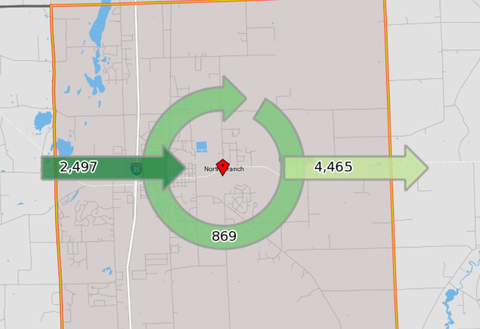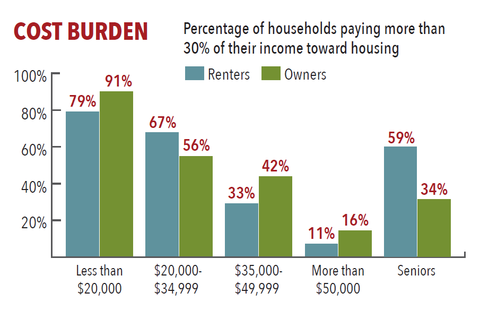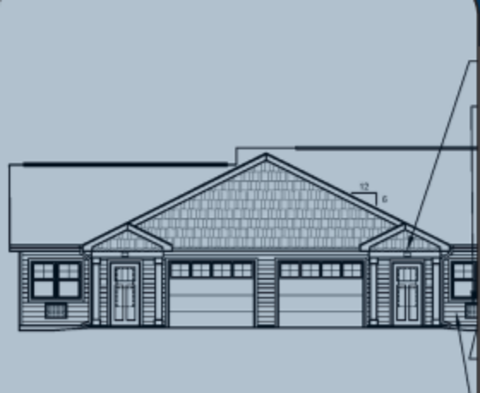Remaking a business park to accommodate a growing workforce
Core housing issues addressed
- Workforce housing
- Lack of housing options
- Supportive housing
- Housing challenges
North Branch has experienced significant change during the last 40 years, expanding from a small town of 1,500 people to a booming bedroom community of more than 10,000. Today, new pressures are growing as residents age and businesses look to house workers locally. While executive homes continue to dot the landscape, city leaders are working to supply housing to meet current demand. Kathy Blomquist, city councilperson, said, “Our city is growing differently than it was in the 1970s and 1980s, and that means determining how our city can supply the needed housing for everyone at different stages of their lives.”
Community profile
The Great Recession, coupled with a period of high gas prices, disproportionately affected the city where a majority of its residents commute daily to the Twin Cities for work (Figure 1).
This situation led leaders to focus on affordable housing, a need reflected in community statistics. Chisago County, where North Branch is located, has the 6th highest cost of living in the state, according to the Minnesota Department of Employment and Economic Development (Cost of Living Report, 2016).
In particular, renter households suffered. Despite median rent prices increasing 13 percent between 2000 and 2015, median incomes for renters decreased 15 percent, according to 2017 Minnesota Housing Partnership (MHP) statistics. Comprising 15 percent of all households, renters cannot afford current fair market rent, a situation stemming from the fact that average wages for current job openings in the county fall short (MHP, 2017). Furthermore, evidence from MHP shows that workforce housing is in short supply. Cost burden analysis indicates a majority of households making less than $35,000 annually are spending more than 30 percent of their income on housing (Figure 2).
In addition, a majority of seniors are also cost burdened. This fact is especially important in a county where the Minnesota Demographic Center projects that more than one-quarter of its population will be over 65 by 2035 (MN Demographers Office, 2016). This trend in Chisago County mirrors the aging trend throughout Minnesota.
Housing success stories
The City of North Branch has actively worked to launch two housing developments in 2017 — Cherokee Place and Willow Grove. The two developments serve two different target populations. Cherokee Place will primarily provide options for wage-earning families in the workforce, and Willow Grove will house residents with a history of mental health challenges.
The 48 townhouse units of Cherokee Place will be located in the city’s business park. The location has a Tax Increment Financing (TIF) housing district in place, so it is already zoned for high-density housing. The new housing development is the first project in the district. The units are designed for wage-earning families with a household income up to $56,000 and will range from one to three bedrooms. The development will also house five long-term homeless units. Commonwealth Management Corporation is partnering with the City of North Branch to develop and manage the property. Sponsors estimate the project will cost a total of $9 million.
Willow Grove will consist of 20 units with on-site support services and will be located near job opportunities within walking distance. The Central Minnesota Housing Partnership is working with the city to co-sponsor the facility, which is focused on supporting the community’s most vulnerable residents. Social service agencies will assess and refer residents to the property where they will receive 24-hour support and counseling services. Chisago County has pledged contributions to help support these services. These ongoing costs, however, are separate from the cost of developing the $4.1 million property, most of which came from bonding capital from Minnesota Housing, the state’s housing finance agency.
Project partnership
The two projects had different partners and a different degree of complexity, reflecting distinct project scopes. Both, however, were made possible through 2017 funding from Minnesota Housing.
Commonwealth Development, a private development company, worked closely with the City of North Branch to develop Cherokee Place. The city’s planning commission and Economic Development Authority (EDA) led efforts to discuss housing needs in the community with the Commonwealth Development. Once built, Metro Plains, an asset management firm, will oversee the property.
The Central Minnesota Housing Partnership introduced the vision of Willow Grove to the city. The organization chose North Branch because of the community’s job opportunities for residents. According to Deanna Hemmesch, executive director of Central Minnesota Housing Partnership, “The city portion of support is key to the project. Not only for funding — points are awarded by Minnesota Housing based on the funds received from local contributions, like TIF, etc.— but also for making the development process go smoothly.” The willingness of the city to support the project in multiple ways (e.g., having the city engineer perform a plan review) was instrumental to success.
Both projects addressed important components of the city’s housing strategy. North Branch combined the projects when applying for funding from the Minnesota Housing’s consolidated application for multiple funding sources, including low-income tax credits and state infrastructure bonding. The city’s community development director, Carla Vita, guided the application to a successful end and gathered letters of support. Many signed on, including private businesses, local government leaders, Chisago County HRA/EDA, Minnesota state legislators, Congressman Rick Nolan, and housing supporters, like the local chapter of Habitat for Humanity.
Programs and financial resources
Both developments use a mix of funding sources, including both local and state funding through Minnesota Housing.
Cherokee Place (est. total cost - $9 million)
- Minnesota Housing Finance: $6.6 million
- Federal Low Income Tax Credit Equity: $2.4 million
Willow Grove (est. total cost - $4.1 million)
- Minnesota Housing Finance: $2.3 million
- Chisago County: $50,000 annually for staff support
- Greater Minnesota Housing Fund: $250,000
- Federal Low Income Tax Credit Equity: $976,000
Who can you follow up with to learn more or to clarify housing project details?
1. Renae Fry, city administrator
Phone: 651-674-8113 | Email: renaef@ci.north-branch.mn.us
2. Carla Vita, community development coordinator
Phone: 651-674-8113 | Email: carlav@ci.north-branch.mn.us
3. Kathy Blomquist, city council member
Phone: 651-247-9355 | Email: kblomquist@midco.net
- Correspondence with city staff and Central Minnesota Housing Partnership staff, 2018.
- Minnesota Demographic Center, County Population Projections, 2017.
- Department of Employment and Economic Development, Cost of Living Report, 2016.
- Census Bureau, On the Map, 2017.
- Minnesota Housing Partnership, Housing Profiles, 2017.
- Minnesota Housing: 2017 Consolidated Funding Selections.
- Chisago County Press. (2017, October 7). Funds awarded to North Branch to fund 68 units.
About the MN Rural Housing study
Small rural communities in Minnesota face persistent housing challenges. In 2017, the state’s regional development organizations (RDOs) identified housing as a top learning focus and called for the creation of case studies that highlight creative solutions to persistent housing issues confronting our smaller communities. This project is a collaboration of the Extension Department of Community Development and the Center for Small Towns.
Reviewed in 2018





